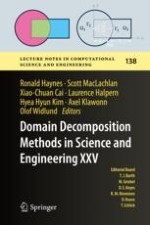2020 | Buch
Domain Decomposition Methods in Science and Engineering XXV
herausgegeben von: Prof. Dr. Ronald Haynes, Prof. Dr. Scott MacLachlan, Prof. Xiao-Chuan Cai, Prof. Laurence Halpern, Prof. Hyea Hyun Kim, Prof. Axel Klawonn, Prof. Dr. Olof Widlund
Verlag: Springer International Publishing
Buchreihe : Lecture Notes in Computational Science and Engineering
